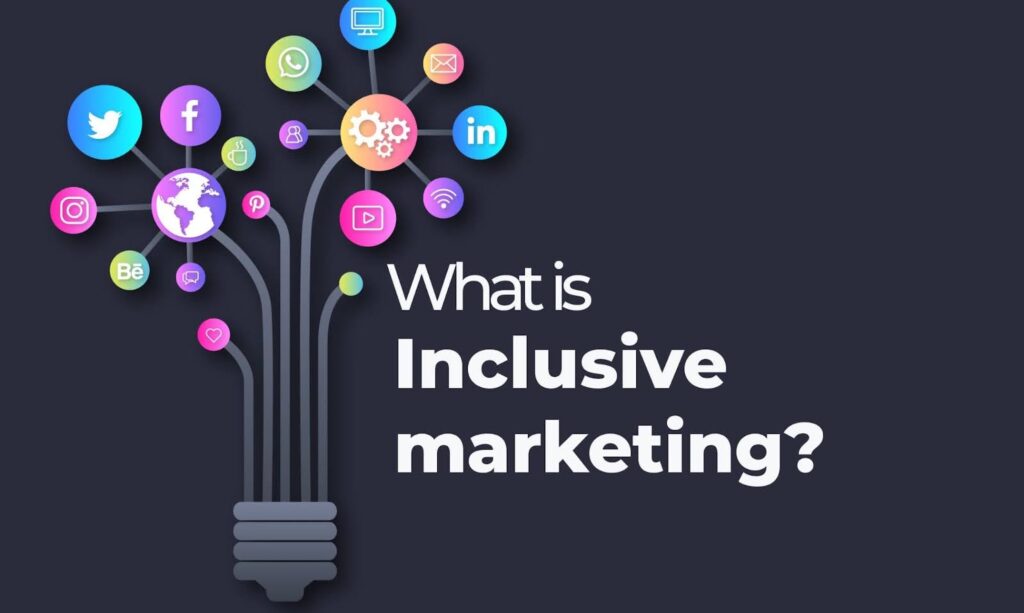In today’s diverse world, consumers expect brands to reflect the communities they serve.
Inclusive marketing has become a crucial aspect of successful brand campaigns, going beyond just selling products and services. It’s about fostering genuine connections with audiences by acknowledging and celebrating their unique experiences and identities.
In today’s diverse world, inclusive marketing has become an essential brand strategy. It’s about creating campaigns that resonate with people from all walks of life. But what exactly does inclusive marketing entail?
This comprehensive blog explores the importance of inclusive marketing, its benefits, and practical steps to implement it in your brand campaigns.
Understanding Inclusive Marketing
What is Inclusive Marketing?

Inclusive marketing is a powerful tool that brands use to celebrate diversity in their advertising and promotional efforts. It’s all about acknowledging and embracing the many dimensions of human diversity, including factors like age, gender, ethnicity, culture, body type, sexual orientation, gender identity, language, religion, and more.
This approach extends to experiential diversity as well, encompassing differences in physical and mental abilities, military status, marital status, parental status, immigration status, socio-economic status, and job function.
When brands embrace inclusive marketing, they recognize that their audience comprises people from various backgrounds and perspectives. It’s about acknowledging and celebrating the uniqueness of each individual and ensuring that everyone feels represented and valued in brand campaigns. Whether it’s in advertisements for food, apparel, technology, or auto goods, inclusive marketing aims to reflect the diverse tapestry of society.
Inclusive marketing involves creating diverse voices and telling authentic stories that resonate with different audience segments. It’s about crafting messages that speak to people’s lived experiences and acknowledging the richness of their diversity. By embracing inclusivity in their marketing efforts, brands can foster a sense of belonging and connection with their audience.
Inclusive marketing is not just a trend; it’s a fundamental shift in how brands engage with their customers. It’s about more than just selling products or services; it’s about building relationships and fostering understanding. In a world where diversity is celebrated and valued, inclusive marketing is not just good business sense—it’s the right thing to do.
Why Inclusive Marketing Matters
Inclusive marketing transcends mere token gestures. It requires a deep understanding of different audiences and their diverse perspectives. Here’s why embracing inclusivity is vital for your brand:
- Connects with a broader audience: By showcasing diverse individuals in your campaigns, you connect with a wider range of consumers who see themselves reflected in your brand story. This fosters trust and loyalty.
- Boosts brand reputation: Consumers today are increasingly conscious of brands that champion diversity and inclusion. Inclusive marketing demonstrates your commitment to social responsibility and resonates positively with potential customers.
- Enhances creativity and innovation: When diverse teams and perspectives come together, they spark new ideas and lead to more creative and innovative marketing campaigns.
- Improves brand performance: Studies show that brands embracing inclusivity experience positive outcomes, including increased brand awareness, customer engagement, and sales growth.
The Benefits of Inclusive Brand Campaigns
Implementing inclusive marketing strategies in your brand campaigns brings a multitude of benefits:
- Authenticity: Consumers can readily identify inauthentic attempts at inclusivity. By genuinely embracing diversity, you build trust and establish an authentic brand image.
- Brand advocacy: When individuals feel seen and valued by your brand, they are more likely to become brand advocates, promoting your products or services organically to their networks.
- Positive social impact: Inclusive marketing can contribute to positive societal change by challenging stereotypes and promoting acceptance and understanding.
- Competitive advantage: In a crowded marketplace, standing out requires differentiation. Inclusive marketing sets you apart and positions your brand as a leader in embracing diversity.
Building Inclusive Brand Campaigns: A Step-by-Step Guide.
Ready to integrate inclusive marketing into your brand campaigns? Here’s a step-by-step guide to get you started:
1. Understand Your Audience
The first step is to gain a deep understanding of your target audience. This goes beyond demographics like age and gender. Consider factors like:
- Cultural background: Explore the diverse cultural backgrounds within your target audience to understand their unique values and perspectives.
- Socioeconomic status: Be mindful of the varying needs and aspirations of individuals across different socioeconomic groups.
- Ability and disability: Ensure your campaigns are accessible to individuals with disabilities by incorporating features like closed captions on videos or alternative text descriptions for images.
- Sexual orientation and gender identity: Understand and respect the diverse range of sexual orientations and gender identities within your audience.
2. Build a Diverse Team
Building a diverse team within your organization is crucial for creating truly inclusive marketing campaigns. This allows for the inclusion of diverse perspectives at the conception and development stages, ensuring authenticity and avoiding potential missteps.
3. Be Mindful of Language and Imagery
Language and imagery are powerful tools that can either promote inclusivity or reinforce stereotypes. Here are some key considerations:
- Avoid harmful stereotypes: Avoid using language or imagery that perpetuates harmful stereotypes about any group of people.
- Use inclusive language: Opt for gender-neutral language and avoid biased terms or assumptions.
- Employ diverse visuals: Ensure your visuals accurately represent the diversity of your target audience, featuring individuals of various ethnicities, genders, ages, and abilities.
4. Partner with Diverse Creators and Influencers
Collaboration with diverse creators and influencers can significantly enhance your brand’s inclusive marketing efforts. These individuals bring their unique perspectives and voices to the table, helping you reach broader audiences and foster authentic connections.

5. Prioritize Accessibility and Usability
Make sure your marketing materials, including websites, social media content, and advertisements, are accessible to everyone. This includes features like:
- Alt text descriptions for images: These allow visually impaired individuals to understand the content of images.
- Closed captions for videos: This ensures individuals who are deaf or hard of hearing can access video content.
- Keyboard navigation: Users should be able to navigate your website using just a keyboard, ensuring accessibility for individuals with limited motor skills.
Remember, inclusive marketing is an ongoing journey, not a one-time effort. By continuously learning, adapting, and refining your approach, you can create successful brand campaigns that resonate with diverse audiences and contribute to a more inclusive and equitable world.
Building on the foundation laid out in the previous sections, let’s delve deeper into specific aspects of inclusive marketing and explore additional strategies to strengthen your brand campaigns.

Addressing Potential Challenges
While the benefits of inclusive marketing are undeniable, incorporating it into your campaigns can present some challenges. Here are some common roadblocks and how to navigate them:
- Unconscious bias: Everyone has unconscious biases, which can unintentionally lead to exclusionary practices. Regularly educating yourself and your team about unconscious bias and its impact is crucial.
- Lack of diverse representation: Addressing a lack of diversity within your organization can be an initial hurdle. Partnering with external diverse consultants and creators can help bridge this gap in the interim.
- Negative feedback: Implementing inclusive marketing may occasionally lead to negative feedback from some individuals. It’s important to address concerns respectfully while remaining true to your brand’s commitment to inclusivity.

Examples of Inclusive Marketing in Action
Seeing diverse representation in action can be inspiring. Here are a few real-world examples of brands successfully implementing inclusive marketing strategies:
- Dove’s “Real Beauty” campaign: This long-running campaign celebrates the beauty of women in all shapes, sizes, and ethnicities, challenging traditional beauty standards and promoting self-acceptance.
- Nike’s “Dream Crazier” campaign: This campaign features female athletes, including those with disabilities, advocating for equality and challenging societal expectations placed on women.
- P&G’s “Thank You, Mom” campaign: This campaign celebrates the diverse roles mothers play in their children’s lives, showcasing mothers from different backgrounds and family structures.
These examples demonstrate how inclusive marketing can be effective in connecting with audiences, fostering positive social change, and achieving brand success.
Beyond the Basics: Expanding Your Inclusive Marketing Strategies
Moving beyond the foundational elements, here are some additional strategies to further enhance your inclusive marketing efforts:
- Focus on intersectionality: Recognize that individuals hold multiple identities and experiences that shape their perspectives. Consider the intersection of various aspects like race, gender, and ability when crafting your marketing messages.
- Embrace cultural nuances: When targeting diverse cultural groups, it’s crucial to understand their specific cultural nuances and avoid making assumptions based on stereotypes. Partnering with individuals from these communities can provide valuable insights.
- Leverage data and research: Data and research can help you understand your audience better and tailor your marketing messages accordingly. However, be mindful of potential biases within data sets and ensure ethical data collection practices.
- Embrace ongoing learning: Inclusive marketing is a continuous process of learning and evolution. Stay updated on the latest trends and best practices, and actively seek feedback from diverse audiences to refine your approach.
Conclusion: The Power of Inclusive Marketing
In today’s interconnected world, embracing diversity and representation is not just a trend; it’s a necessity for successful brand marketing. By implementing inclusive marketing strategies, you can connect with a broader audience, build stronger brand loyalty, and contribute to a more inclusive and equitable society. Remember, inclusivity is not a box to tick, but a journey of continual learning, understanding, and action. By committing to this journey, you can create marketing campaigns that resonate with diverse audiences and set your brand apart as a leader in inclusivity. This extended blog, with its additional sections and examples, offers a more comprehensive understanding of inclusive marketing, addressing potential challenges, and providing practical strategies for implementation. By expanding on the core information and exploring diverse perspectives, this revised version aims to provide valuable insights for marketers seeking to build successful and inclusive brand campaigns.

